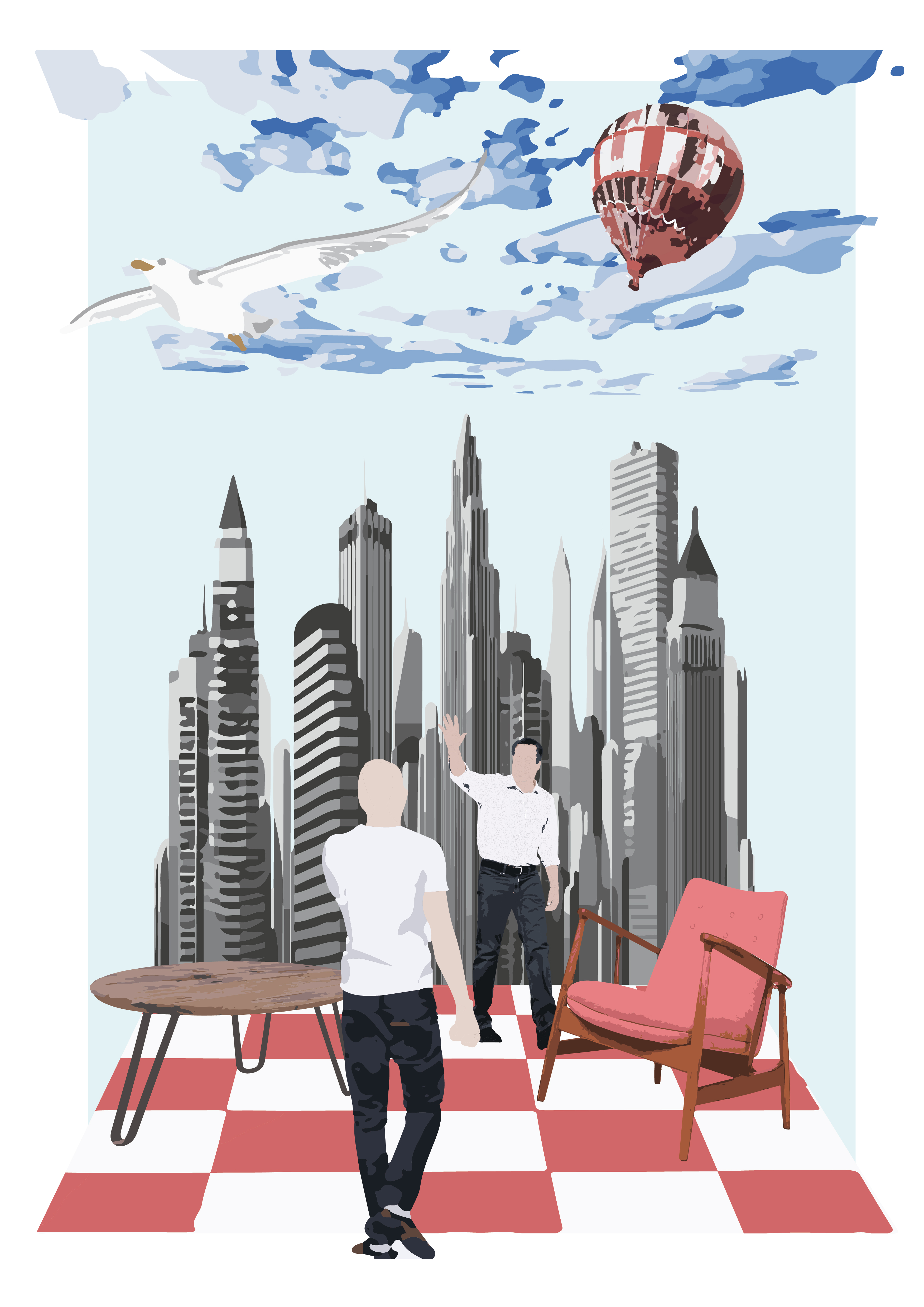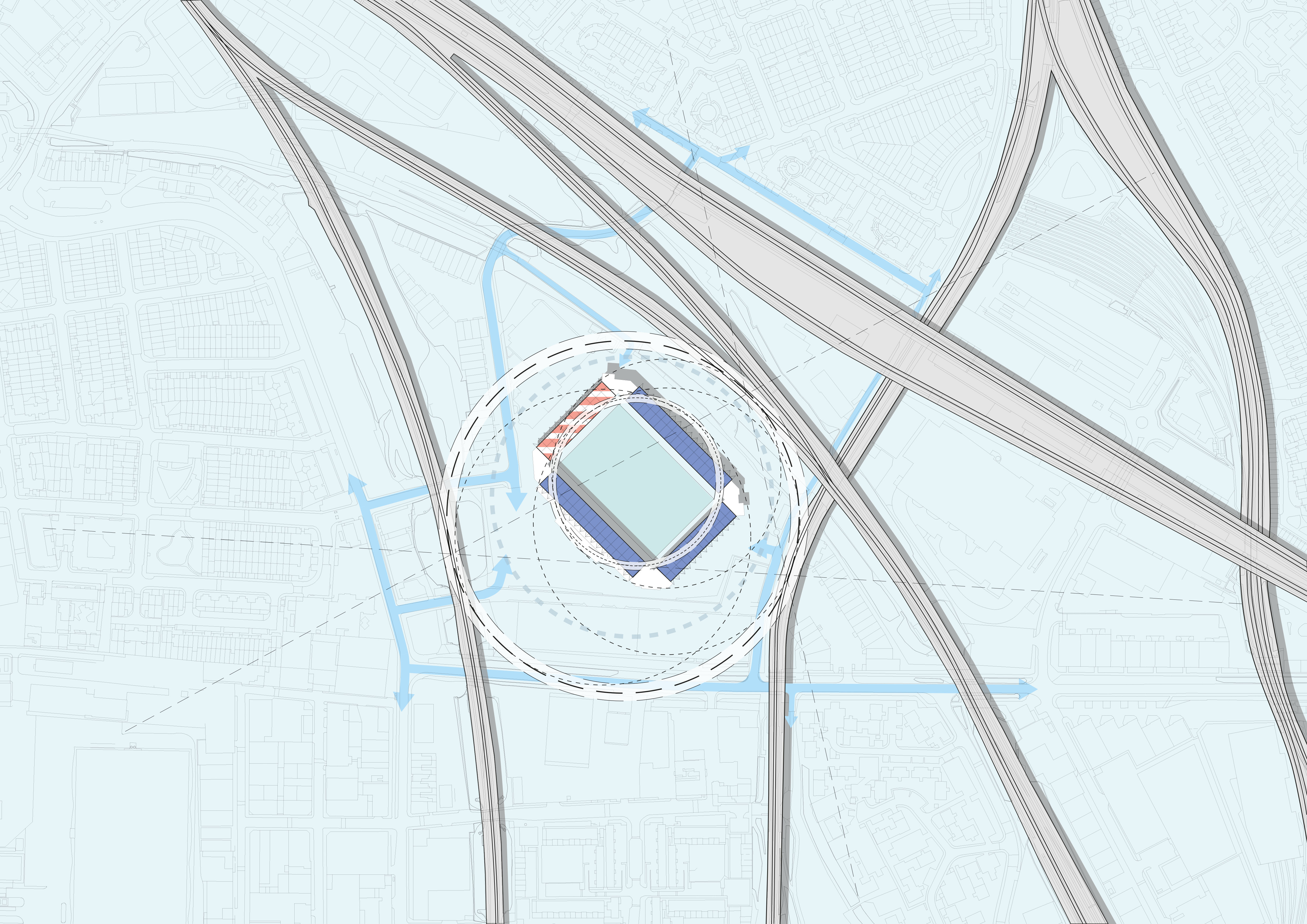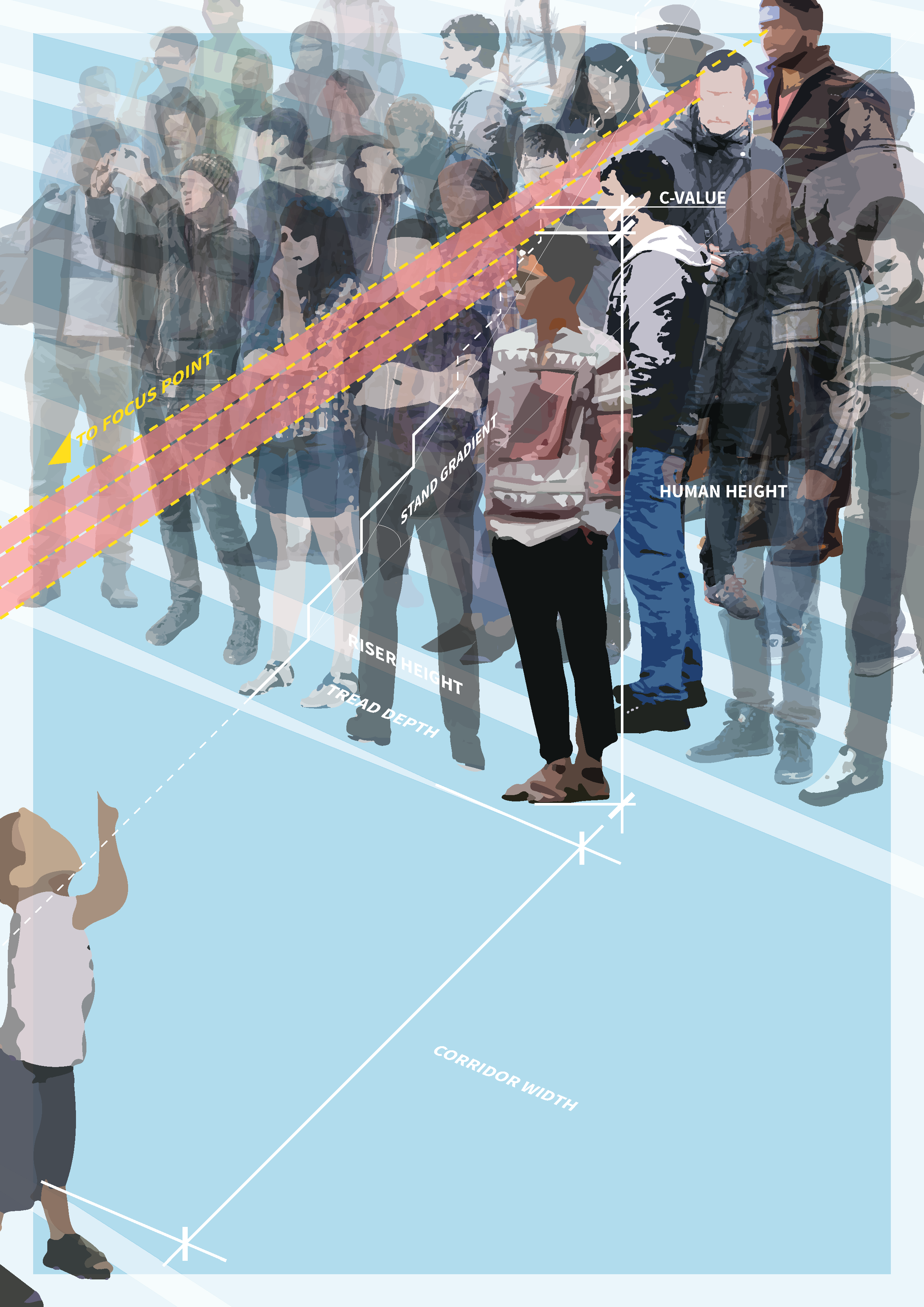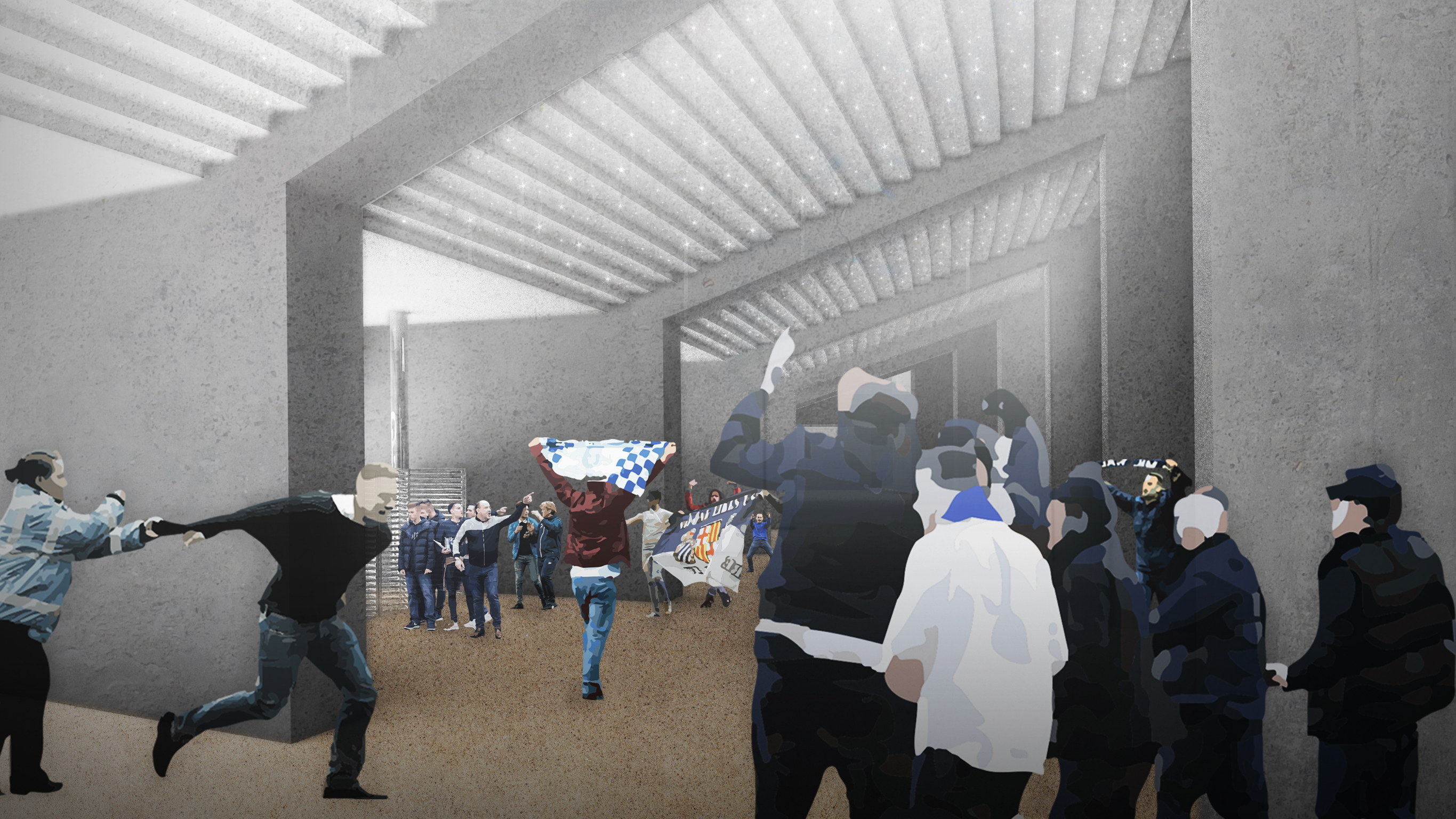Centripetal Common
‘Where’, the word we use to locate the position, is interpreted differently among people due to their own experiences. In space, we question ourselves, ‘Am I too close?’ or ‘Should I be closer?’ when we are not so confident about whether we are in the ‘right position’. The feeling of ‘inappropriateness’ directs our movement to create an equilibrium with a foreign body. The following question will be ‘how far should I be further apart or closer to?’, which leads us to the next step of action. Distance from one another plots the pattern that illustrates the tension in spatial relationships between two individuals, whether centripetal or centrifugal. The presentation for all our ‘where we should be’ decision-making tasks becomes a set of rules for ourselves, which is institutional. However, the standardisation for this specific institution is still undefined as a universal system. This is because everyone has his own scale of measure, and even hard to stay stable.
Here is another question for ourselves: Sometimes we gather, but do we really like each other?

Proxemics - A Theory by Edward T. Hall

Welcome to My Territories
Proxemics is the theory firstly coined by Edward T Hall in his publication, “The Hidden Dimension”, in 1966. It is the study of man’s perception and use of space, which is developed from the observation of animal behaviours and how they react to foreign species.
It has long been believed that all men share the ability to bypass language and culture and refer back to experience to reach another human being. This implicit and often explicit belief concerning man’s relation to experience was based on the assumption that when two human beings are subject to the same “experience,” virtually the sam data are being fed to the two central nervous systems, and the two brains record similarly.
However, Edward Hall was convinced that most spatial interpretation is outside of our awareness. He believed that the difference in cultural contents has created barriers to communication and group activities. Selective screening of sensory data admits some things while filtering out others; so that experience as it is perceived through one set of culturally patterned sensory screens is quite different from experience perceived through another.
It has long been believed that all men share the ability to bypass language and culture and refer back to experience to reach another human being. This implicit and often explicit belief concerning man’s relation to experience was based on the assumption that when two human beings are subject to the same “experience,” virtually the sam data are being fed to the two central nervous systems, and the two brains record similarly.
However, Edward Hall was convinced that most spatial interpretation is outside of our awareness. He believed that the difference in cultural contents has created barriers to communication and group activities. Selective screening of sensory data admits some things while filtering out others; so that experience as it is perceived through one set of culturally patterned sensory screens is quite different from experience perceived through another.
The architectural and urban environments that people create are expressions of this filtering-screening process. The feeling of one’s proximity to others will vary on how different people use their senses. Also, experiences are activities that exist in the man-altered environment. Therefore, the experience cannot be counted on as a stable point of reference because it occurs in a setting that has been moulded by man And the title of his book, “The Hidden Dimension”, describes the theory of proxemics, which is an invisible measure in mankind. Hall thought there was a great need to revise and broaden our view of the human situation, a need to be more comprehensive and realistic about others and us. He believed it was essential that we should learn to read silent communications as quickly as printed and spoken ones. Only by doing so can we reach other people, both inside and outside our national boundaries, as we are increasingly required to do so.
Hall also believed all cultures are rooted in common biology, and that is why he uses studies on animal behaviour to discover how humans will act. For instance, it is the nature of animals, including humans, to exhibit behaviour, which we call territoriality. H. Hediger, Zurich’s famous animal psychologist, described the most critical aspects of territoriality and explained succinctly the mechanisms by which it operates. Territoriality, he says, ensures the propagation of the species by regulation density. It
provides a framework in which things are done-places to learn, places to play, and safe places to hide. Thus, it coordinates the activities of the group and holds the group together.

Fighting for Territory

Coexist

An Invisible Personal Bubble
Nevertheless, the psychologist C. T. Carpenter, who pioneered th observation of monkeys in a native setting, was trying to list all functions of territoriality, including important ones relating to the protection and evolution of the species. The list indicated the essential nature of territoriality as a behavioural system, which evolved in the same way as anatomical systems evolved.
Studies of territoriality show that animals are often imprisoned in their own territories. Some mark their space with urine to stake a claim for privacy. Hall says people have territoriality, and he has invented many
ways of defending what he considers his own land, turf, or spread, by using furniture, walls, and fences to accomplish the same purpose By starting with comparative studies of animals, Hall was convinced each animal would be surrounded by a series of bubble-shaped balloons, and defined them as intimate, personal, social and public distances.
Visitors vs Invaders
Proxemics is a set of rules to translate human knowledge of spatial relationships along with emotional feeling into the measurement. But these measures are doubted by some. Hall’s research doesn’t take into account different cultural backgrounds and life experiences which is a critical component of today’s diverse society. Proxemics changes our view from being described as groups of people sharing ethical similarities, to individuals with unique characteristics to form groups. To adapt to this
condition spatially, some of us have to give up our notion of absolute personal comfort and negotiate with others to maximise both parties’ best-fit proximity.
We usually see that people waiting for trains tend to spread out along the platform. Starting from one, two, three, then more until it reaches its adequate capacity, it constantly alters one’s understanding of intimacy.
However, being separate from strangers is not always the case in positioning yourself in a shared space. In a home match of your favourite team, the radar for ‘keeping the distance’ to an unknown person will be suddenly deactivated. Sitting by a stranger may not be an issue anymore. It brings up the terminology of common ground, which is described as opinions or interests shared by each of two or more parties, and certainly brings people closer in the crowd on stands, where you will be cheering or even hugging each other that you will only do to your closest ones as described by Hall, no matter what background people are from. It emphasises the local distinctiveness, or simply the spirit of space, where people can actually share their understanding of being together as a group but also apart as individuals.


Spatial Orientation vs Real Feelings
The Dark Place or Utopia?
Centripetal Common, where territorial occupancy is undefined, is a testing ground for how extreme the spatial relationships between two bodies can be, either extremely far apart or extremely close. It questions ourselves, and the measure of proxemics.
Centripetal Common, where territorial occupancy is undefined, is a testing ground for how extreme the spatial relationships between two bodies can be, either extremely far apart or extremely close. It questions ourselves, and the measure of proxemics.

The Existing Millwall Football Ground - It’s all about segregation

The Corrected Form:
From ‘The Den’ to ‘The Den(city)’
The Intervention
As a member of this modernised society, we are constantly experiencing a high level of social interaction with foreign bodies and objects. We perceive our movement or action to the interaction that an optimistic proximity to another is presented in the scenario. We have our own rules of approaching others, or accepting approaches from others. On a platform of tube station, we often find ourselves in a position where the distance to other passengers is pleasant. While during peak hours, this ‘pleasantness‘ is shrunken and all we can do is to adapt ourselves to a more crowded space. We mostly see this ‘minimal pleasantness’ as uncomfortable, as a result in majority of us are from a non-contact culture. In our minds, we are not active in approaching to a stranger in such environment, however, we have no other better choices to maintain our position within the environment. Especially when the population of the city is growing and at its highest ever figure, and the land resource is limited, the boundary of our ‘personal space’ becomes rigidless.
As a citizen living in this metropoli, we are gradually losing our distinctiveness in the society, and simply described as ‘part of the crowd’. Nevertheless, the crowd to some authorities is being considered as threats and potentially hazardous. In other words, we, as individuals, are better to be isolated and stay individual.
The Enquiry Report on Hillsborough Disaster has been rewritten and republished in 2016. However, the image of crowd behaviour has already been mistakenly advertised and also shaped infrastructures would have possibly been built in other forms. This project, the Centripetal Common, is focusing on remodelling the public’s perception on crowd through refining the Millwall FC football ground, the first stadium built after Hillsborough Disaster under the reviewed Football Association’s regulation influenced by the sanitised police report. The project also promotes a miniature of the society, a deformation of personal space, an alternative stage for individuals.
As a member of this modernised society, we are constantly experiencing a high level of social interaction with foreign bodies and objects. We perceive our movement or action to the interaction that an optimistic proximity to another is presented in the scenario. We have our own rules of approaching others, or accepting approaches from others. On a platform of tube station, we often find ourselves in a position where the distance to other passengers is pleasant. While during peak hours, this ‘pleasantness‘ is shrunken and all we can do is to adapt ourselves to a more crowded space. We mostly see this ‘minimal pleasantness’ as uncomfortable, as a result in majority of us are from a non-contact culture. In our minds, we are not active in approaching to a stranger in such environment, however, we have no other better choices to maintain our position within the environment. Especially when the population of the city is growing and at its highest ever figure, and the land resource is limited, the boundary of our ‘personal space’ becomes rigidless.
As a citizen living in this metropoli, we are gradually losing our distinctiveness in the society, and simply described as ‘part of the crowd’. Nevertheless, the crowd to some authorities is being considered as threats and potentially hazardous. In other words, we, as individuals, are better to be isolated and stay individual.
The Enquiry Report on Hillsborough Disaster has been rewritten and republished in 2016. However, the image of crowd behaviour has already been mistakenly advertised and also shaped infrastructures would have possibly been built in other forms. This project, the Centripetal Common, is focusing on remodelling the public’s perception on crowd through refining the Millwall FC football ground, the first stadium built after Hillsborough Disaster under the reviewed Football Association’s regulation influenced by the sanitised police report. The project also promotes a miniature of the society, a deformation of personal space, an alternative stage for individuals.


The Science of ‘Getting it Cosy’

The Narrative of ‘Getting it Close’

Continously Exhibiting the Millwall Spirit
